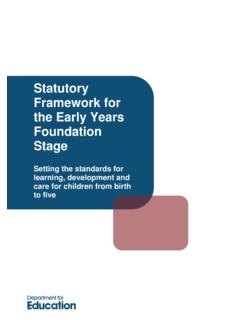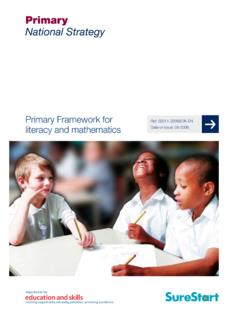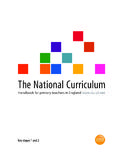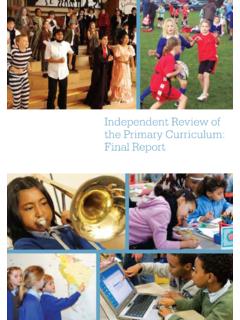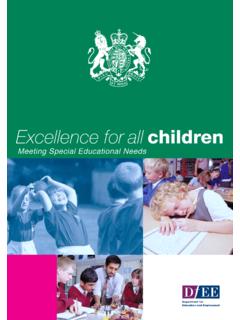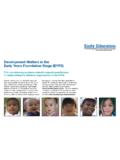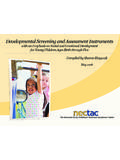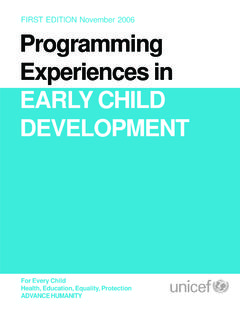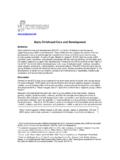Transcription of Early Years Foundation Stage Pro le
1 National Curriculum assessmentsEarly Years Foundation Stage Profile Handbook2 013 EYFS Crown copyright 20122013 Early Years Foundation Stage Handbook Product code: STA/13/6106/e PDF version ISBN: 978-1-4459-5882-8 You may re-use this information (excluding logos) free of charge in any format or medium, under the terms of the Open Government Licence. To view this licence, visit or email Where we have identified any third party copyright information you will need to obtain permission from the copyright holders concerned. This publication is also available for download at Early Years Foundation Stage Profile Handbook 3 Contents1. Introduction The statutory framework for the Early Years Foundation Stage The EYFS Profile Ongoing assessment Structure of this Handbook 52. EYFS Profile purposes, principles and processes Purposes and main uses of the EYFS Profile Principles of EYFS Profile assessments EYFS Profile assessment processes Evidence and documentation of the assessments Use of the EYFS Profile for transition to Key Stage 1 133.
2 Inclusion Children with special educational needs and disability Children for whom English is not their home language Children from minority groups Taking account of the needs of individual children Transition conversations for children with an outcome at the emerging level. 174. Completing the EYFS Profile Making EYFS Profile assessments Recording children s attainment Exceptions and exemptions Characteristics of effective learning Reporting the EYFS Profile assessment 215. Exemplification of expected descriptors Introduction How to use the exemplification Areas and aspects of learning of EYFS and their associated ELGs 236. Moderation of the EYFS Profile Purpose of moderation Internal moderation Local authority requirements for moderation STA external moderation of local authority moderation models Moderation training cycle The moderation of children with outcomes in the emerging band The moderation of children with outcomes in the exceeding band Key elements of an effective moderation process 357.
3 Quality assurance of the EYFS Profile The pattern of outcomes for an individual child The role of settings in quality assurance Data entry and submission Local authority review of submitted data 458. Glossary 474 2013 Early Years Foundation Stage Profile Handbook1. Introduction The statutory framework for the Early Years Foundation StageThe Early Years Foundation Stage (EYFS) is the statutory framework published in 2012 by the Department for Education that sets the standards for the development, learning and care of children from birth to five. The Childcare Act Section 39(1)(a) 2006 stipulates that Early Years providers must ensure that their provision meets the learning and development requirements as specified in the EYFS (Learning and Development Requirements) Order 2007 (amended in 2012). The Act states that this Order can specify the arrangements which are required for assessing children for the purpose of ascertaining what they have achieved in relation to the Early learning goals (ELGs).
4 As an executive agency of the Department, the Standards and Testing Agency (STA) is responsible for the development and delivery of statutory assessment through the EYFS Profile and at key stages 1, 2, and 3. It will ensure that EYFS Profile outcomes are reliable as a result of robust moderation. All English local authorities must have regard to any guidance produced by STA in exercising their function under the EYFS (Learning and Development Requirements) Order 2007, Section The learning and development requirements are given legal force by an Order made under Section 39(1) (a) of the Childcare Act 2006. This can be viewed on the Government s legislation archive at: The EYFS ProfileThe EYFS Profile summarises and describes children s attainment at the end of the EYFS. It is based on ongoing observation and assessment in the three prime and four specific areas of learning, and the three learning characteristics, set out below:The prime areas of learning: communication and language physical development personal, social and emotional developmentThe specific areas of learning: literacy mathematics understanding the world expressive arts and design2013 Early Years Foundation Stage Profile Handbook 5 The learning characteristics: playing and exploring active learning creating and thinking criticallyA completed EYFS Profile consists of 20 items of information: the attainment of each child assessed in relation to the 17 ELG descriptors, together with a short narrative describing the child s three learning will be based primarily on observation of daily activities and events.
5 Practitioners should note in particular the learning which a child demonstrates spontaneously, independently and consistently in a range of contexts. Accurate assessment will take account of a range of perspectives including those of the child, parents and carers and other adults who have significant interactions with the each ELG, practitioners must judge whether a child is meeting the level of development expected at the end of the Reception year (expected), exceeding this level (exceeding), or not yet reaching this level (emerging). The completed EYFS Profile must include a short commentary on each child s skills and abilities in relation to the three key characteristics of effective learning. This will support future curriculum planning and will provide the year 1 teacher with important information about each child s approach to Ongoing assessment The Government does not prescribe how ongoing assessment should be undertaken. In addition to the statutory framework, an updated version of the non-statutory Development matters guidance was published alongside the EYFS in March 2012.
6 Early Years providers will find these useful in helping them to make judgements about the ongoing monitoring and assessment of children, prior to undertaking the EYFS Profile. Both documents are available on the Department s website at EYFS Profile is not intended to be used for ongoing assessment or for entry level assessment for Early Years settings or Reception Structure of this HandbookThe Handbook has been developed to support practitioners in making accurate judgements about each child s attainment. It also provides exemplification to enable effective moderation of judgements so that EYFS Profile outcomes are accurate and consistent across all settings. This Handbook is effective from September 2012, replacing the previous EYFS Profile Handbook (Qualifications and Curriculum Authority, 2008). Sections 1 8 of this document provide advice and guidance on the various elements of EYFS Profile assessment, in particular: principles, purposes and processes of the EYFS Profile; completing the EYFS Profile; exemplification of the ELGs; 6 2013 Early Years Foundation Stage Profile Handbook documenting each child s attainment; inclusion; moderating EYFS Profile judgements; and quality assuring the assessments.
7 A range of documents and web based resources have been developed to assist practitioners in completing EYFS Profiles. These give the background to the statutory framework, and detail specific aspects of moderation, reporting to parents and data collection. All these resources are available on the Department s website at term parent is used in this document as defined in section 576 of the Education Act 1996 as: parents of a child; any person who is not a parent of a child but who has parental responsibility for the child; and any person who has care of the references to EYFS settings include any out-of-home provider of Early Years provision for children from birth to five, such as childminders, local authority nurseries, nursery or Early Years centres, children s centres, playgroups, pre-schools, or schools in the independent, private or voluntary sector and maintained Early Years Foundation Stage Profile Handbook 7 2. EYFS Profile purposes, principles and Purposes and main uses of the EYFS ProfileThe EYFS (Learning and Development Requirements) Order 2007 as amended by The EYFS (Learning and Development Requirements) (Amendment) Order 2012 specifies the learning and development requirements and gives legal effect to the EYFS statutory framework.
8 The framework requires that the EYFS Profile is carried out in the final term of the year in which the child reaches age five, and no later than 30 June in that primary purpose of the EYFS Profile is to provide a reliable, valid and accurate assessment of individual children at the end of the EYFS. The primary uses of EYFS Profile data are as follows. These have informed the development of the Profile. To inform parents about their child s development against the ELGs and the characteristics of their learning. To support a smooth transition to Key Stage 1 by informing the professional dialogue between EYFS and Key Stage 1 teachers. To help year 1 teachers plan an effective, responsive and appropriate curriculum that will meet the needs of all children. In addition, the Department considers that a secondary purpose of the assessment is to provide an accurate national data set relating to levels of child development at the end of the EYFS which can be used to monitor changes in levels of children s development and their readiness for the next phase of their education both nationally and locally (school-level results will not be published in the Performance Tables).
9 The EYFS Profile has been designed to be valid and reliable for these 2013 Early Years Foundation Stage Profile Principles of EYFS Profile assessmentsHow an EYFS Profile is completedEvidence from parents/carersIs the child at the expected level of development?LA quality assurance and submission of Profile data to the DfELA external moderation of the ProfileIs the child at the emerging level of development?Is the child at the exceeding level of development?Evidence from other relevant adultsEvidence from the childPractioner knowledge - matched to exemplification of national standardsEvidence within observational materials Setting internal moderation of the ProfileNONOYESYESYESS etting quality assurance and submission of Profile data to the LACompletion of each ELG and characteristics of learning within the EYFS ProfileReliable and accurate assessment at the end of the EYFS is underpinned by the following principles: Reliable and accurate assessment is based primarily on the practitioner s knowledge of the child gained predominantly from observation and interaction in a range of daily activities and events.
10 Responsible pedagogy must be in place so that the provision enables each child to demonstrate their learning and development fully. Embedded learning is identified by assessing what a child can do consistently and independently in a range of everyday situations. An effective assessment presents a holistic view of a child s learning and development. Accurate assessments take account of contributions from a range of perspectives including the child, their parents and other relevant Early Years Foundation Stage Profile Handbook 9 Observational assessmentObservational assessment involves reaching an understanding of children s learning by watching, listening and interacting as they engage in everyday activities, events and experiences, and demonstrate their specific knowledge, skills and is the most reliable way of building up an accurate picture of children s development and learning, especially where the attainment demonstrated is not dependent on overt adult support. Observational assessment is key to understanding what children really know and can do.
